Related Research Articles

Blues is a music genre and musical form that originated amongst African-Americans in the Deep South of the United States around the 1860s. Blues has incorporated spirituals, work songs, field hollers, shouts, chants, and rhymed simple narrative ballads from the African-American culture. The blues form is ubiquitous in jazz, rhythm and blues, and rock and roll, and is characterized by the call-and-response pattern, the blues scale, and specific chord progressions, of which the twelve-bar blues is the most common. Blue notes, usually thirds, fifths or sevenths flattened in pitch, are also an essential part of the sound. Blues shuffles or walking bass reinforce the trance-like rhythm and form a repetitive effect known as the groove.
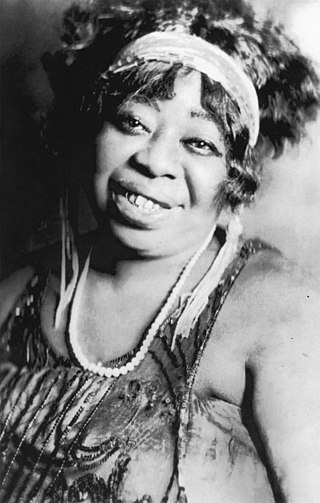
Gertrude "Ma" Rainey was an American blues singer and influential early-blues recording artist. Dubbed the "Mother of the Blues", she bridged earlier vaudeville and the authentic expression of southern blues, influencing a generation of blues singers. Rainey was known for her powerful vocal abilities, energetic disposition, majestic phrasing, and a "moaning" style of singing. Her qualities are present and most evident in her early recordings "Bo-Weevil Blues" and "Moonshine Blues".

Thomas Andrew Dorsey was an American musician, composer, and Christian evangelist influential in the development of early blues and 20th-century gospel music. He penned 3,000 songs, a third of them gospel, including "Take My Hand, Precious Lord" and "Peace in the Valley". Recordings of these sold millions of copies in both gospel and secular markets in the 20th century.

Spencer Williams was an American jazz and popular music composer, pianist, and singer. He is best known for his hit songs "Basin Street Blues", "I Ain't Got Nobody", "Royal Garden Blues", "I've Found a New Baby", "Everybody Loves My Baby", "Tishomingo Blues", and many others.
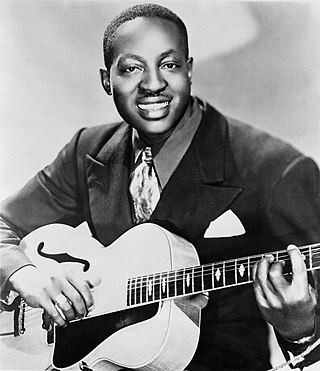
Big Bill Broonzy was an American blues singer, songwriter, and guitarist. His career began in the 1920s, when he played country music to mostly African-American audiences. In the 1930s and 1940s, he navigated a change in style to a more urban blues sound popular with working-class black audiences. In the 1950s, a return to his traditional folk-blues roots made him one of the leading figures of the emerging American folk music revival and an international star. His long and varied career marks him as one of the key figures in the development of blues music in the 20th century.
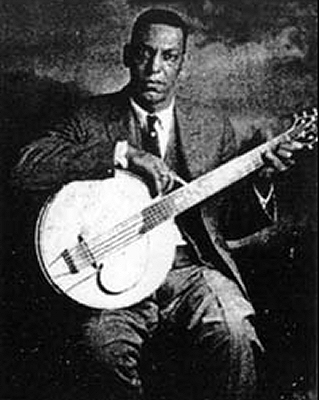
William Henry "Papa Charlie" Jackson was an early American bluesman and songster who accompanied himself with a banjo guitar, a guitar, or a ukulele. His recording career began in 1924. Much of his life remains a mystery, but his draft card lists his birthplace as New Orleans, Louisiana, and his death certificate states that he died in Chicago, Illinois, on May 7, 1938.
The origins of rock and roll are complex. Rock and roll emerged as a defined musical style in the United States in the early to mid-1950s. It derived most directly from the rhythm and blues music of the 1940s, which itself developed from earlier blues, the beat-heavy jump blues, boogie woogie, up-tempo jazz, and swing music. It was also influenced by gospel, country and western, and traditional folk music. Rock and roll in turn provided the main basis for the music that, since the mid-1960s, has been generally known simply as rock music.

Henry Thomas was an American country blues singer, songster and musician. Although his recording career, in the late 1920s, was brief, Thomas influenced performers including Bob Dylan, Taj Mahal, the Lovin' Spoonful, the Grateful Dead, and Canned Heat. Often billed as "Ragtime Texas", Thomas's style is an early example of what later became known as Texas blues guitar.
Classic female blues was an early form of blues music, popular in the 1920s. An amalgam of traditional folk blues and urban theater music, the style is also known as vaudeville blues. Classic blues were performed by female singers accompanied by pianists or small jazz ensembles and were the first blues to be recorded. Ma Rainey, Bessie Smith, Ethel Waters, and the other singers in this genre were instrumental in spreading the popularity of the blues.

Hudson Whittaker, known as Tampa Red, was an American Chicago blues musician.
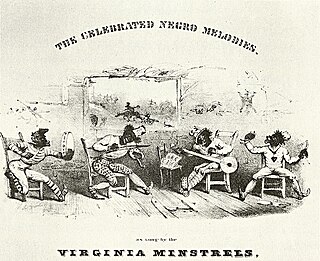
Hokum is a particular song type of American blues music—a song which uses extended analogies or euphemistic terms to make humorous, sexual innuendos. This trope goes back to early dirty blues recordings, enjoyed huge commercial success in the 1920s and 1930s, and is used from time to time in modern American blues and blues rock.
Isaac L. "Banjo Ikey" Robinson was an American banjoist and vocalist.

Jim Jackson was an American blues and hokum singer, songster, and guitarist, whose recordings in the late 1920s were popular and influential on later musicians.
Dirty blues is a form of blues music that deals with socially taboo and obscene subjects, often referring to sexual acts and drug use. Because of the sometimes graphic subject matter, such music was often banned from radio and available only on jukeboxes. The style was most popular in the years before World War II, although it experienced a revival in the early 1950s.

Chicago, Illinois is a major center for music in the midwestern United States where distinctive forms of blues, and house music, a genre of electronic dance music, were developed.
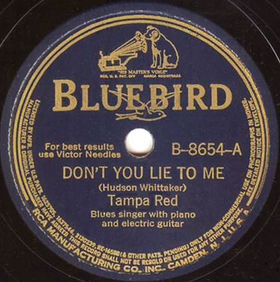
"Don't You Lie to Me" is a song recorded by Tampa Red in 1940. It became popular with blues artists, leading it to become a blues standard. The song was also interpreted by rock and roll pioneers Fats Domino and Chuck Berry.
Madlyn Davis was an American classic female blues singer, active as a recording artist in the late 1920s. Among her best-known tracks are "Kokola Blues" and "It's Red Hot". She was a contemporary of better-known recording artists, such as Ma Rainey, Bessie Smith, Clara Smith, Mozelle Alderson, Victoria Spivey, Sippie Wallace, and Bertha "Chippie" Hill. Little is known of her life outside music.
Mozelle Alderson was an American classic female blues singer. She recorded a small number of tracks for Black Patti Records in 1927 and for Brunswick Records In 1930. Her most regular pianist was Judson Brown. She was a one-time vocalist for the Famous Hokum Boys in 1930 and toured and recorded as a backing vocalist for other blues artists. Alderson used a number of aliases, possibly including Kansas City Kitty, Hannah May, Thelma Holmes, Mae Belle Lee, and Jane Lucas.
"Hokum Boys" was the billing of multiple jazz bands active in 1920s and 1930s. The hokum subgenre of blues music got its name from these bands.
"Shake That Thing" is a song recorded by Papa Charlie Jackson in 1925, one of the earliest blues standards and a forerunner of hokum. Paramount Records issued it on the B-side of the then standard 10-inch 78 rpm shellac record on July 11, 1925. The song is also known as a first hit record where the male singer accompanies himself. The title of the song contains double entendre: at the time "shake it" was a vulgar euphemism for coitus.
References
- 1 2 3 4 Staig 1993, Obit.
- 1 2 Russell 1997, pp. 173–174.
- ↑ Harris 1992, pp. 67–90.
- ↑ Lieb 1983, p. 28.
- ↑ Lieb 1983, p. 35.
- ↑ Lieb 1983, p. 37.
- ↑ Schwartz 2018, pp. 369–370.
- 1 2 3 4 "'It's Tight Like That' by Tampa Red & Georgia Tom (Vocalion 1928)". Blues Foundation . November 10, 2016. Retrieved February 27, 2022.
- ↑ O'Neal & van Singel 2013.
- ↑ Schwartz 2018, p. 370.
- ↑ Oliver & Wright 1990, p. 281.
- 1 2 "Thomas A. Dorsey, Father of Gospel Music, Dies at 93". The Washington Post . January 25, 1993. Retrieved June 24, 2023.
- ↑ Harris 1992, p. 99.
- 1 2 3 Humphrey 1994, p. 6.
- ↑ "Tampa Red : It's Tight Like That". Tunebat.com. Retrieved February 27, 2022.
- ↑ Schwartz 2018, p. 372.
- ↑ "Tampa Red Vol. 1 (1928-1929)". Document Records . Retrieved February 27, 2022.
- ↑ Humphrey 1994, p. 3.
- ↑ Harris 1992, pp. 117–150.
- ↑ Harris 1992, pp. 180–208.
- ↑ Birnbaum 2013, pp. 133–134.
- ↑ Schwartz 2018, pp. 383–388.